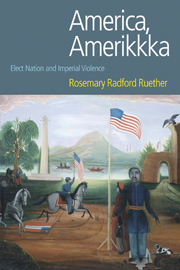Book contents
- Frontmatter
- Dedication
- Contents
- Introduction: THE TWO FACES OF AMERICA: THE IDEAL AMERICA AS DECEPTION AND AS PROTEST
- Chapter One ELECT NATIONS OF EUROPE AND THE MAKING OF THE AMERICAN MYTH OF CHOSENNESS
- Chapter Two THE RIGHTS OF MAN AND THE EXCLUDED OTHERS — THE REVOLUTIONARY ERA AND BEYOND
- Chapter Three MANIFEST DESTINY AND ANGLO-SAXON RACISM — 1815-1875
- Chapter Four MANIFEST DESTINY AND AMERICAN EMPIRE: 1890-1934
- Chapter Five AMERICA'S GLOBAL MISSION: THE COLD WAR ERA, 1945-89
- Chapter Six AMERICAN EMPIRE AND ITS DENOUEMENT: 1990-2007
- Chapter Seven ALTERNATIVE VISIONS OF AMERICA: THE PROTEST TRADITION
- Chapter Eight TOWARD A U.S. THEOLOGY OF LIBERATION AND LETTING GO
- BIBLIOGRAPHY
- INDEX OF BIBLICAL REFERENCES
- GENERAL INDEX
Chapter One - ELECT NATIONS OF EUROPE AND THE MAKING OF THE AMERICAN MYTH OF CHOSENNESS
- Frontmatter
- Dedication
- Contents
- Introduction: THE TWO FACES OF AMERICA: THE IDEAL AMERICA AS DECEPTION AND AS PROTEST
- Chapter One ELECT NATIONS OF EUROPE AND THE MAKING OF THE AMERICAN MYTH OF CHOSENNESS
- Chapter Two THE RIGHTS OF MAN AND THE EXCLUDED OTHERS — THE REVOLUTIONARY ERA AND BEYOND
- Chapter Three MANIFEST DESTINY AND ANGLO-SAXON RACISM — 1815-1875
- Chapter Four MANIFEST DESTINY AND AMERICAN EMPIRE: 1890-1934
- Chapter Five AMERICA'S GLOBAL MISSION: THE COLD WAR ERA, 1945-89
- Chapter Six AMERICAN EMPIRE AND ITS DENOUEMENT: 1990-2007
- Chapter Seven ALTERNATIVE VISIONS OF AMERICA: THE PROTEST TRADITION
- Chapter Eight TOWARD A U.S. THEOLOGY OF LIBERATION AND LETTING GO
- BIBLIOGRAPHY
- INDEX OF BIBLICAL REFERENCES
- GENERAL INDEX
Summary
The Christian Bible combines the literatures of two religious communities, the Hebrew Bible and the New Testament. The second claims to inherit, perfect and supersede the first, yet the relation between the two remains in constant tension and reinterpretation within Christianity. One of these themes of reinterpretation is the idea of an elect nation, God's chosen people. For the ancient Hebrews, as well as the Jewish people through the ages, the chosen people are Israel, a particular people created by a religiously defined ethnicity. Israel is those who covenant with the God of Israel to be his people, yet Jewishness is also an inherited ethnicity. This national God gave his people the law as a way of life through whose observance obedience to God is fulfilled.
This God also promised his people a land and a flourishing future in relation to all the other nations in the Middle East. But these promises remained continually postponed. The people of Israel were a small nation or federation of tribes, who only in brief periods were politically independent and ruled over a few neighboring tribes. For most of their history to the first century BCE they were ruled by other empires. After the Jewish Wars of 66-73 CE and 132-36 CE, the Jews were scattered in or migrated to other areas within and beyond the borders of the Roman Empire.
- Type
- Chapter
- Information
- America AmerikkkaElect Nation and Imperial Violence, pp. 7 - 32Publisher: Acumen PublishingPrint publication year: 2007



